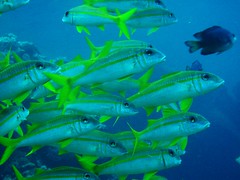
These are the cameras for rent at Diveaway Fiji!
Stuart
============================================
SeaLife introduces new Digital PRO Flash and repositions Reefmaster Mini
Digital PRO Flash
At DEMA 2007, Sealife introduced the Digital PRO Flash – SL961, which replaces the Digital Flash – SL960D.
The Digital PRO Flash is compatible with any Sealife camera as well as all other brands of digital underwater cameras. It also features a new AUTO mode setting, which automatically adjusts the flash brightness for the optimal image exposure. A variable power adjustment setting allows the user to manually fine-tune the brightness for the desired effect.
“The best underwater photographs capture a whole other world,” said
Depth tested up to 200 feet (60m), this flash has an effective underwater distance range up to about 8 feet (2.5m), which makes it one of the most powerful flashes available in the market. Its flexible, rubberized arm allows for a sure grip and easy aiming. The flash is operated by 4 AA batteries for approximately 100 flashes.
The Sealife Digital PRO Flash includes a universal mount, an optical cable connection which attaches to any camera as well as a deluxe carrying case. The Digital PRO Flash has a suggested list price of $399.95 and MAP of $349.95.
New Pricing
As of November 1, 2007 Sealife has repositioned its ReefMaster Mini and Ecoshot cameras, just in time for the Holidays. The ReefMaster mini will now have a Sugg. Retail of $279.95 while the Ecoshot will be at $229.95 Sugg. Retail. Both cameras are in stock and available for immediate shipment.
For more details, visit the Sealife Cameras website at www.sealife-cameras.com




